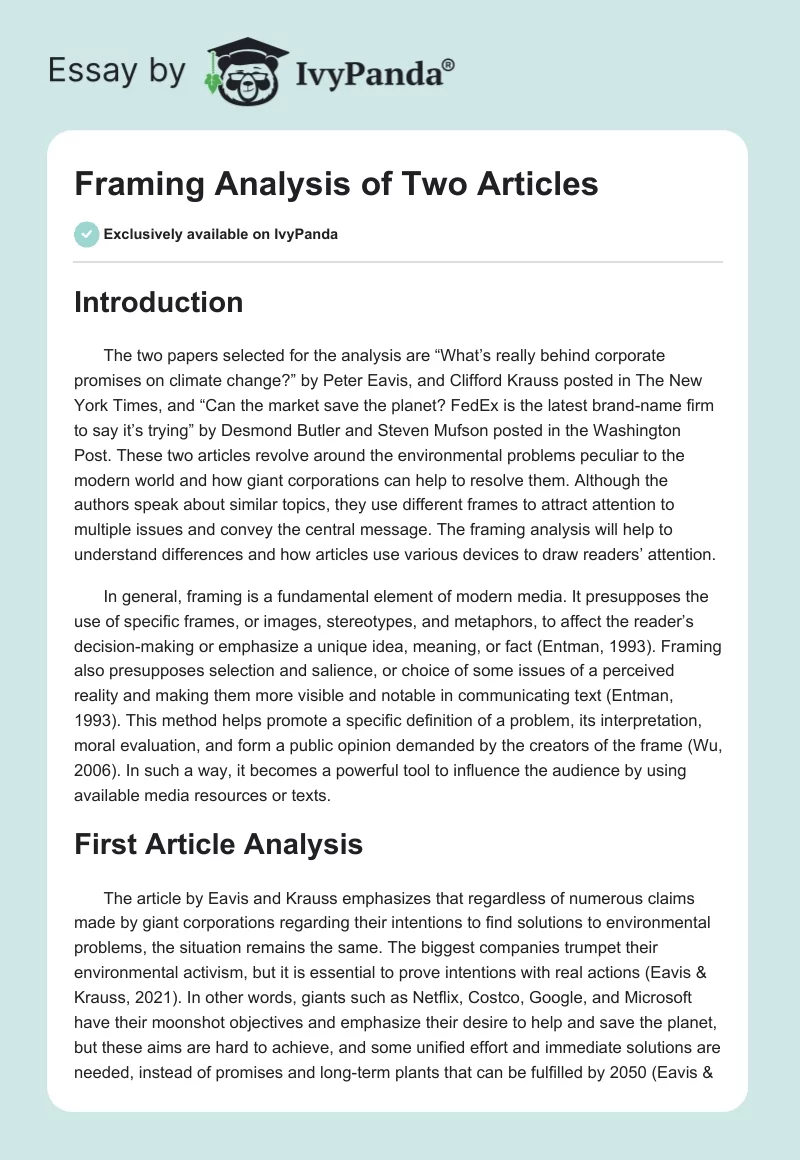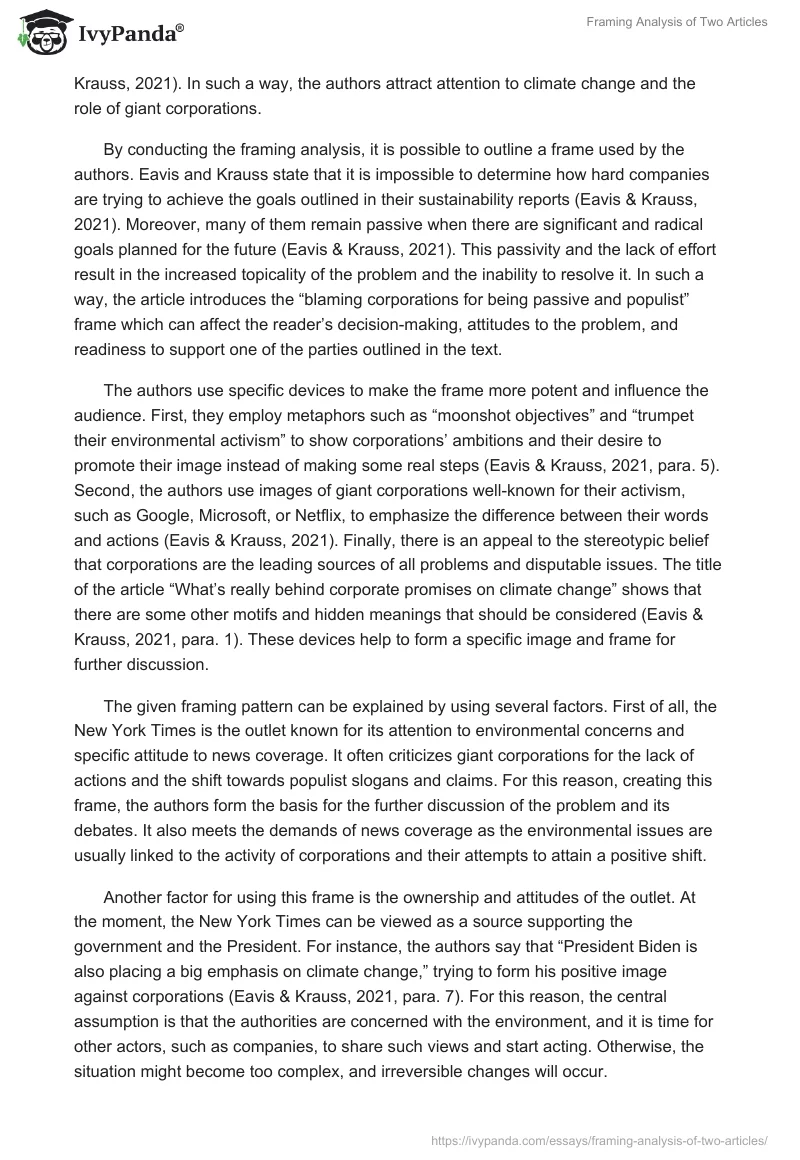Introduction
The two papers selected for the analysis are “What’s really behind corporate promises on climate change?” by Peter Eavis, and Clifford Krauss posted in The New York Times, and “Can the market save the planet? FedEx is the latest brand-name firm to say it’s trying” by Desmond Butler and Steven Mufson posted in the Washington Post. These two articles revolve around the environmental problems peculiar to the modern world and how giant corporations can help to resolve them. Although the authors speak about similar topics, they use different frames to attract attention to multiple issues and convey the central message. The framing analysis will help to understand differences and how articles use various devices to draw readers’ attention.
In general, framing is a fundamental element of modern media. It presupposes the use of specific frames, or images, stereotypes, and metaphors, to affect the reader’s decision-making or emphasize a unique idea, meaning, or fact (Entman, 1993). Framing also presupposes selection and salience, or choice of some issues of a perceived reality and making them more visible and notable in communicating text (Entman, 1993). This method helps promote a specific definition of a problem, its interpretation, moral evaluation, and form a public opinion demanded by the creators of the frame (Wu, 2006). In such a way, it becomes a powerful tool to influence the audience by using available media resources or texts.
First Article Analysis
The article by Eavis and Krauss emphasizes that regardless of numerous claims made by giant corporations regarding their intentions to find solutions to environmental problems, the situation remains the same. The biggest companies trumpet their environmental activism, but it is essential to prove intentions with real actions (Eavis & Krauss, 2021). In other words, giants such as Netflix, Costco, Google, and Microsoft have their moonshot objectives and emphasize their desire to help and save the planet, but these aims are hard to achieve, and some unified effort and immediate solutions are needed, instead of promises and long-term plants that can be fulfilled by 2050 (Eavis & Krauss, 2021). In such a way, the authors attract attention to climate change and the role of giant corporations.
By conducting the framing analysis, it is possible to outline a frame used by the authors. Eavis and Krauss state that it is impossible to determine how hard companies are trying to achieve the goals outlined in their sustainability reports (Eavis & Krauss, 2021). Moreover, many of them remain passive when there are significant and radical goals planned for the future (Eavis & Krauss, 2021). This passivity and the lack of effort result in the increased topicality of the problem and the inability to resolve it. In such a way, the article introduces the “blaming corporations for being passive and populist” frame which can affect the reader’s decision-making, attitudes to the problem, and readiness to support one of the parties outlined in the text.
The authors use specific devices to make the frame more potent and influence the audience. First, they employ metaphors such as “moonshot objectives” and “trumpet their environmental activism” to show corporations’ ambitions and their desire to promote their image instead of making some real steps (Eavis & Krauss, 2021, para. 5). Second, the authors use images of giant corporations well-known for their activism, such as Google, Microsoft, or Netflix, to emphasize the difference between their words and actions (Eavis & Krauss, 2021). Finally, there is an appeal to the stereotypic belief that corporations are the leading sources of all problems and disputable issues. The title of the article “What’s really behind corporate promises on climate change” shows that there are some other motifs and hidden meanings that should be considered (Eavis & Krauss, 2021, para. 1). These devices help to form a specific image and frame for further discussion.
The given framing pattern can be explained by using several factors. First of all, the New York Times is the outlet known for its attention to environmental concerns and specific attitude to news coverage. It often criticizes giant corporations for the lack of actions and the shift towards populist slogans and claims. For this reason, creating this frame, the authors form the basis for the further discussion of the problem and its debates. It also meets the demands of news coverage as the environmental issues are usually linked to the activity of corporations and their attempts to attain a positive shift.
Another factor for using this frame is the ownership and attitudes of the outlet. At the moment, the New York Times can be viewed as a source supporting the government and the President. For instance, the authors say that “President Biden is also placing a big emphasis on climate change,” trying to form his positive image against corporations (Eavis & Krauss, 2021, para. 7). For this reason, the central assumption is that the authorities are concerned with the environment, and it is time for other actors, such as companies, to share such views and start acting. Otherwise, the situation might become too complex, and irreversible changes will occur.
Second Article Analysis
The second article is also focused on the problems of climate change. Butler and Mufson (2021) speak about FedEx’s attempts to become more environmentally friendly, change the world, and attract attention to climate change problems. The corporation promises to become carbon-neutral by 2040, which demands much resources and attention from the CEO (Butler & Mufson, 2021). However, even the achievement of this goal by FedEx will help to reduce the U.S. carbon emissions by 0.3%, meaning that there is the need for cooperation and other corporations’ involvement to improve the situation and find the technology helping to avoid drastic climate change (Butler & Mufson, 2021, para. 4). Discussing this problem, the authors introduce some frames needed to convey their message.
From the fame analysis, it is possible to see how the frame is introduced by the authors. They emphasize that FedEx, other companies joining similar incentives, and specialists should unite to save the planet. Butler and Mufson say, “The idea for that is to have some of the smartest people in the country, in the world, working on these intractable, intractable problems” (Butler & Mufson, 2021, para. 28). In such a way, the authors use the “join us” frame to show the necessity of the unified effort of all actors who can contribute to the improvement of the situation and find some effective and practical solutions to the problem of climate change.
The authors chose specific devices that help them to create the desired effect and influence the audience. First of all, Butler and Mufson (2021) appeal to the authority of recognized people who offer their views on the problem in multiple interviews. It helps to show readers the importance and significance of the arguments provided to support the frame. Another device is the contrast, as FedEx and its incentives are opposed to the passivity of other agents and the impossibility to attain specific goals (Butler & Mufson, 2021). Finally, there are some metaphors, such as “climate change is bigger than any one business,” which are viewed as a powerful framing device helping to shape the decision-making of the audience (Butler & Mufson, 2021, para. 29). Utilizing these elements, the authors manage to create a particular frame and make it stronger.
Thus, this text composition and frame are explained by some external factors. First of all, the Washington Post is the outlet supporting the ideas of environmental activism and the necessity for a unified effort. For this reason, it emphasizes the need for the combined effort, which can be achieved by following the FedEx example. Moreover, the traditional news coverage peculiar to this newspaper presupposes appeals to other companies to join using some positive experiences. Under these conditions, this approach to framing is linked to the nature of the outlet, and the way it presents information and cooperates with partners.
Furthermore, the Washington Post is a source for political news supporting the existing government and the President. It means that the major assumptions made in the text and the frames follow this pattern and are designed to influence the decision-making of readers in a particular way (Knüpfer & Entman, 2018). In other words, it serves the government to attract attention to a certain issue and guarantee that companies will be influenced by people as they depend on potential clients. In such a way, the second article presents framing devices vital for forming the image required by the dominant political power.
Comparison
Comparing both texts selected for the analysis, it is possible to find both similarities and differences. First of all, both outlets support the dominant political forces, meaning that the central messages and images used in the texts are influenced by the current policies and values. Moreover, both articles focus on environmental concerns emphasizing the need for immediate action because of the complexity of the situation and its possible deterioration in the future. The authors also use metaphors as strong framing devices to attract attention to a particular problem, which is preconditioned by the power of this tool and its ability to influence the audience.
At the same time, there are many differences between the analyzed papers. They have different frames, which are “blaming corporations for being passive and populist” and “joining” correspondingly. They are preconditioned by the need to discuss specific aspects linked to the attempts to resolve the problem of climate change. Furthermore, the first article uses stereotypes and images as framing devices, while the second one appeals to authority and contrasts to convey the central message. These differences are vital for understanding the nature of selected articles, the main ideas discussed, and the authors’ views on the problem.
Conclusion
Altogether, frames are potent tools that are used by the authors to structure the effects of media and make them more powerful and accurate. The framing analysis conducted using the two selected articles helps to see how employing specific framing devices, such as metaphors, comparisons, and stereotypes, the writers emphasize some ideas and make readers devote more attention to them. The formation of such frames is also affected by external factors, such as the focus on the outlet, the way it covers news, and its belonging to a particular political force.
References
Butler, D., & Mufson, S. (2021). Can the market save the planet? FedEx is the latest brand-name firm to say it’s trying. The Washington Post. Web.
Eavis, P., & Krauss, C. (2021). What’s really behind corporate promises on climate change? The New York Times. Web.
Entman, R. M. (1993). Framing: Toward clarification of a fractured paradigm. Journal of Communication, 43(4), 51-58.
Knüpfer, C. B., & Entman, R. M. (2018). Framing conflicts in digital and transnational media environments. Media, War & Conflict, 11(4), 476–488. Web.
Wu, M. (2006). Framing AIDS in China: A comparative analysis of US and Chinese wire news coverage of HIV/AIDS in China. Asian Journal of Communication, 16(3), 251-272.


